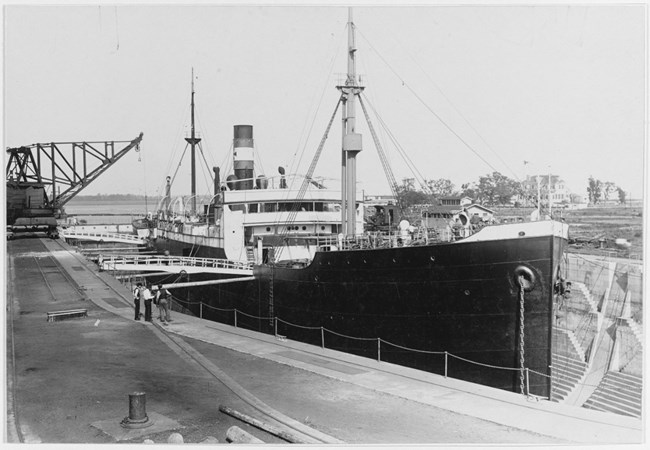Last updated: November 27, 2018
Article
Sabotage and Naval Preparedness in Charleston

Naval History and Heritage Command
"Federal officers had been unable tonight to ascertain the cause of the sinking of the 2,830-ton German freighter Liebenfels, of the Hausa line, which settled to the bottom in the harbor here today under circumstances that led marine men to believe she had been scuttled", as reported by the New York Times.
Before the United States of America entered the Great War on the side of the Allies, a forgotten incident of German sabotage occurred in the Cooper River near Charleston, SC. The Liebenfels was sunk on January 31, 1917, coinciding with the break in diplomatic relations between the USA and Germany. The following day, Germany announced a return to their practice of unrestricted submarine warfare. Neutral nations like the United States feared the effects of this policy on their shipping and ability to stay out of the conflict. The story of the Liebenfels would not end there: the vessel would be raised and outfitted for service as an American naval vessel, the Houston, in the Charleston Navy Yard.
A failed German act of sabotage would prove to be an asset for the US Navy.
The Liebenfels was raised by army engineers and moved to the Navy Yard for repairs. After the American declaration of war in April, five German vessels interned in Charleston Harbor were similarly overhauled and refitted at the Yard. These six vessels, given new American names, would be welcome additions to an expanding US Navy. The Liebenfels was commissioned as the Houston on July 3, 1917 and saw service in convoys to France, transporting vital wartime goods like coal, oil, trucks, and airplanes. Writing in 1919, the commandant of the Sixth Naval District, headquartered in Charleston, stated that conversion of enemy vessels was probably the most important work done by Navy Yard workmen during the war.
Eight of the ship’s officers were convicted for their role in the conspiracy and sentenced to a year in an Atlanta penitentiary. In another trial on October 12, 1917, Johann R. Klattenhof, the ship’s captain, and Paul Wierse, a Charleston American editorial writer, were convicted in federal court of conspiracy to sink the ship in Charleston Harbor and sentenced to two years. They acted upon orders from the German government, likely the German consul in Atlanta, William Muller. Muller fled to Ecuador and could only be sentenced in absentia.
Given the escalating demand for labor, employment figures started to rise at the Navy Yard even before American entry in the war. The Navy Yard, by 1919, would employ about 5,000 civilian employees, including African-Americans. Roughly one-fifth of this labor force were women working at the clothing factory, the only one operated by the US Navy. They produced millions of garments during the war, and by January 1919, the factory churned out 11,000 each day. Civilian laborers, among them women and African-Americans, used the war to demonstrate their patriotism and also their active citizenship through marching in Liberty Loan parades, fundraising for the Red Cross, staging receptions for returning veterans, and protesting poor service from a local cable car company.
While the Great War brought devastation and suffering to continental Europe, American entry in the war boosted Charleston’s economy. The expansion of the American economy to produce war materials for Europe allowed the US to transition to a peacetime economy that focused on consumer goods while a depressed, war-ravaged Europe faced a difficult recovery. The wartime economy also provided women and African-Americans with greater economic, social, and political opportunities than before the war. These opportunities would, unfortunately, be short-lived but would arise again more sustainably during the similar mobilization of the home front during World War II.

Naval History and Heritage Command
